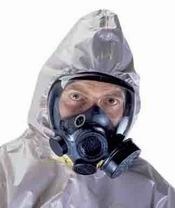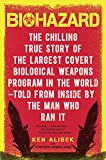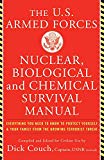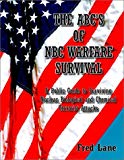 Biological warfare is the most terrifying form of warfare possible, because unlike chemical warfare and nuclear warfare, the tools of biological warfare have an almost unlimited danger of harming friendlies.
Biological warfare is the most terrifying form of warfare possible, because unlike chemical warfare and nuclear warfare, the tools of biological warfare have an almost unlimited danger of harming friendlies.
The ABC’s of NBC Warfare Survival
A Public Guide to Surviving Nuclear, Biological and Chemical Terrorist Attacks
Biological Weapons Technology
Biological agents are naturally occurring microorganisms (bacteria, viruses, fungi) or toxins that can cause disease and death in a target population. They can also attack the food supply and/or materiel of a nation. Biological weapons (BW) which project, disperse, or disseminate biological agents have two characteristics that enhance their effectiveness as weapons: (1) biological agents, other than toxins, reproduce and, therefore, a small amount of infectious agent can cause disease; (2) biological agents, other than toxins, usually require an incubation period of hours to days to manifest signs of exposure so the affected soldier is not certain whether a biological agent attack has occurred until illness sets in.
Neighborhood Emergency Help Center Pamphlet: A Mass Casualty Care Strategy for Biological Terrorism Incidents
In recent years, growing concern over the likelihood of a terrorist attack involving the use of unconventional weapons, such as biological warfare agents, has increased. The threat is indeed serious, and the potential for devastating numbers of casualties is high. Our health and medical community must be prepared to respond to such an event. To facilitate response planning, the Biological Weapons Improved Response Program (BW IRP) developed a mass casualty care concept called the Neighborhood Emergency Help Center (NEHC). This concept describes the first operational component of a comprehensive health and medical response strategy being developed by the BW IRP.
Health aspects of biological and chemical weapons
World Health Organization analysis of the health aspects of the possible hostile use of biological or chemical agents.
The First National Symposium on Medical and Public Health Response to Bioterrorism
On February 16-17, 1999, in Arlington, Virginia, 950 public health officials, physicians, and other medical personnel, along with government, military, and intelligence experts gathered for the first National Symposium on Medical and Public Health Response to Bioterrorism.
Bioterrorism as a Public Health Threat
The threat of bioterrorism, long ignored and denied, has heightened over the past few years. Recent events in Iraq, Japan, and Russia cast an ominous shadow. Two candidate agents are of special concern - smallpox and anthrax. The magnitude of the problems and the gravity of the scenarios associated with release of these organisms have been vividly portrayed by two epidemics of smallpox in Europe during the 1970s and by an accidental release of aerosolized anthrax from a Russian bioweapons facility in 1979. Efforts in the United States to deal with possible incidents involving bioweapons in the civilian sector have only recently begun and have made only limited progress. Only with substantial additional resources at the federal, state, and local levels can a credible and meaningful response be mounted. For longer-term solutions, the medical community must educate both the public and policy makers about bioterrorism and build a global consensus condemning its use.
Reference for Rapid Assessment and Treatment Of Chemical/Biological Agents
Quick reference list for treating casualties of chemical or biological warfare.
Anthrax
Anthrax is an often fatal bacterial infection that occurs when Bacillus anthracis endospores enter the body through abrasions in the skin or by inhalation or ingestion.
Anthrax as a Biological Weapon
Specific consensus recommendations are made regarding the diagnosis of anthrax, indications for vaccination, therapy for those exposed, postexposure prophylaxis, decontamination of the environment, and additional research needs.
Smallpox as a Biological Weapon
Specific recommendations are made regarding smallpox vaccination, therapy, postexposure isolation and infection control, hospital epidemiology and infection control, home care, decontamination of the environment, and additional research needs. In the event of an actual release of smallpox and subsequent epidemic, early detection, isolation of infected individuals, surveillance of contacts, and a focused selective vaccination program will be the essential items of an effective control program.
Emergency Response to Chemical/Biological Terrorist Incidents
In March of 1996, Fire Chief Lamont Ewell, who was then the president of the International Association of Fire Chiefs (IAFC), told the U.S. Senate Permanent Subcommittee on Investigations that it would be the responsibility of local firefighting, police and emergency medical units to cope with a terrorist attack that used nuclear, chemical or biological weapons. He also made the startling announcement that Fire/Police/EMS services, collectively, were not prepared for the challenge.
The Public Health Response to Biological and Chemical Terrorism
Interim Planning Guidance for State Public Health Officials
CDC Emergency Topic: Anthrax
Anthrax is a serious disease caused by Bacillus anthracis, a bacterium that forms spores. A bacterium is a very small organism made up of one cell. Many bacteria can cause disease. A spore is a cell that is dormant (asleep) but may come to life with the right conditions.
CDC Emergency Topic: Smallpox
Smallpox is a serious, contagious, and sometimes fatal infectious disease. There is no specific treatment for smallpox disease, and the only prevention is vaccination. The name smallpox is derived from the Latin word for “spotted” and refers to the raised bumps that appear on the face and body of an infected person.
PBS Online NewsHour: Biological Terrorism
Two experts who served as U.N. arms inspectors in Iraq examine the threat of biological terrorism
PBS: Plague War
A report on the biological weapons threat and how the Soviet Union secretly amassed an arsenal of bio-weapons.
American Biological Safety Association
The American Biological Safety Association (ABSA) was founded in 1984 to promote biosafety as a scientific discipline and serve the growing needs of biosafety professionals throughout the world. Its goals are to provide a professional association that represents the interests and needs of practitioners of biological safety, and to provide a forum for the continued and timely exchange of biosafety in formation.
Center For Infectious Disease Research & Policy
Center for Biosecurity
The Center for Biosecurity of the University of Pittsburgh Medical Center (UPMC) works to prevent the development and use of biological weapons, to catalyze advances in science and governance that diminish the power of biological weapons as agents of mass lethality, and to lessen the human suffering that would result if prevention fails.
Chemical & Biological Weapons Resource Page
Monterey Institute of International Studies
How Biological and Chemical Warfare Works
In this edition of HowStuffWorks, you will learn how chemical and biological weapons really work, how they might be deployed and what the actual threats are.
How Anthrax Works
The threat of anthrax as a biological weapon has become a real concern for everyone. Anthrax is a disease caused not by a virus, but rather by bacteria. There aren’t any known cases of anthrax passing from one person to another, so it is considered to be noncontagious. It is still a large threat, however, because if it isn’t recognized and treated quickly enough it can be deadly. Bacillus anthracis is the bacterium that causes the disease anthrax. It has historically affected herbivores like cattle, sheep or other grazing herds, but has also been a threat to humans who work with these animals and their by-products.
How Cipro Works
Because of all of the news about Anthrax recently, the drug Cipro is being discussed daily. Cipro, the Bayer brand name for the drug ciprofloxacin, is one of the antibiotics that is effective against the anthrax bacteria.
Textbook of Military Medicine: Medical Aspects of Chemical and Biological Warfare
A primary value of the Textbook of Military Medicine series is to preserve the lessons of past wars and, by so doing, demonstrate how current doctrine is built on knowledge that was gained at so high a cost. Medical officers should read this volume, Medical Aspects of Chemical and Biological Warfare, and learn its lessons well. Civilians expect that we in the military will know how to manage chemical and biological casualties. Indeed, if we do not, then who will? The nation expects us to be prepared to defend against all attacks and will be unforgiving of any incapacity on our part.
Biological & Chemical Warfare and Terrorism
Advances Topics on Medical Defense Against Biological and Chemical Agents from the U.S. Army Medical Research and Materiel Command, the Department of Veterans Affairs’ Employee Education System, and the Emergency Management Strategic Healthcare Group.
Red Lies: Biological Warfare and the Soviet Union
It was a horrible accident — for the people who died and for what it revealed. It would show the world the effects of anthrax on a civilian population, and it would expose the existence of a massive biological weapons program in the former Soviet Union; a program, some fear, exists to this day.
Emergency Medicine - Warfare - Chemical, Biological, Radiological, Nuclear And Explosives Articles
U.S. Army Field Manuals on Biological Warfare
FM 3-3
Chemical and Biological Contamination Avoidance
FM 3-7
Nuclear Biological Chemical Field Handbook
FM 3-11
Multiservice Tactics, Techniques, and Procedures for Nuclear, Biological, and Chemical Defense Operations
FM 3-11-3
Multiservice Tactics, Techniques, and Procedures for Chemical, Biological, Radiological, and Nuclear Contamination Avoidance
FM 3-11.4
Multiservice Tactics, Techniques, and Procedures for Nuclear, Biological, and Chemical (NBC) Protection
FM 3-11.21
Multiservice Tactics, Techniques, and Procedures for Nuclear, Biological, and Chemical Aspects of Consequence Management
FM 3-14
Nuclear, Biological, and Chemical (NBC) Vulnerability Analysis
FM 3-101
Chemical Staffs and Units
FM 4-02.7
Health Service Support in a Nuclear, Biological, and Chemical Environment
FM 8-284
Treatment of Biological Warfare Casualties
U.S. Military Departments involved with Biological Warfare
US Army Medical Research Institute of Infectious Diseases
As the Department of Defense’s lead laboratory for medical aspects of biological warfare defense, USAMRIID conducts research to develop vaccines, drugs and diagnostics for laboratory and field use. In addition to developing medical countermeasures, USAMRIID formulates strategies, information, procedures, and training programs for medical defense against biological threats.
Joint Program Executive Office for Chemical and Biological Defense
The JPEO-CBD vision is to eliminate the biological warfare (BW) threat by protecting the warfighter and other users. The JPEO-CBD provides biological warfare protection by rapidly developing, acquiring, and fielding the most effective biological detection, and BD vaccines and medical diagnostic equipment within cost, schedule, performance and logistical parameters.
Chemical and Biological Defense Information Analysis Center
Bringing the CB Defense and Homeland Security Communities Together
Anthrax Vaccine Immunization Program
Vaccination offers a layer of protection in addition to antibiotics and other measures needed for certain memebers of the Armed Forces
Dugway Proving Grounds
The Nations Chemical & Biological Defense Proving Grounds
Medical Research and Materiel Command
Defense Threat Reduction Agency
The Defense Threat Reduction Agency safeguards America’s interests from weapons of mass destruction (chemical, biological, radiological, nuclear and high explosives) by controlling and reducing the threat and providing quality tools and services for the warfighter.
Medical Research Institute of Infectious Diseases
Office of the Deputay Assistant to the Secretary of Defense for Counterproliferation and Chemical and Biological Defense
The mission of the Chemical and Biological Defense Program is to ensure that the U.S. military has the capability to operate effectively and decisively in the face of nuclear, biological, or chemical warfare threats at home or abroad. The mission of the Counterproliferation Program is to ensure that the U.S. military has the capability to prevent, stop and roll back the proliferation of weapons of mass destruction and their means of delivery and protect against the threat posed by those weapons.




